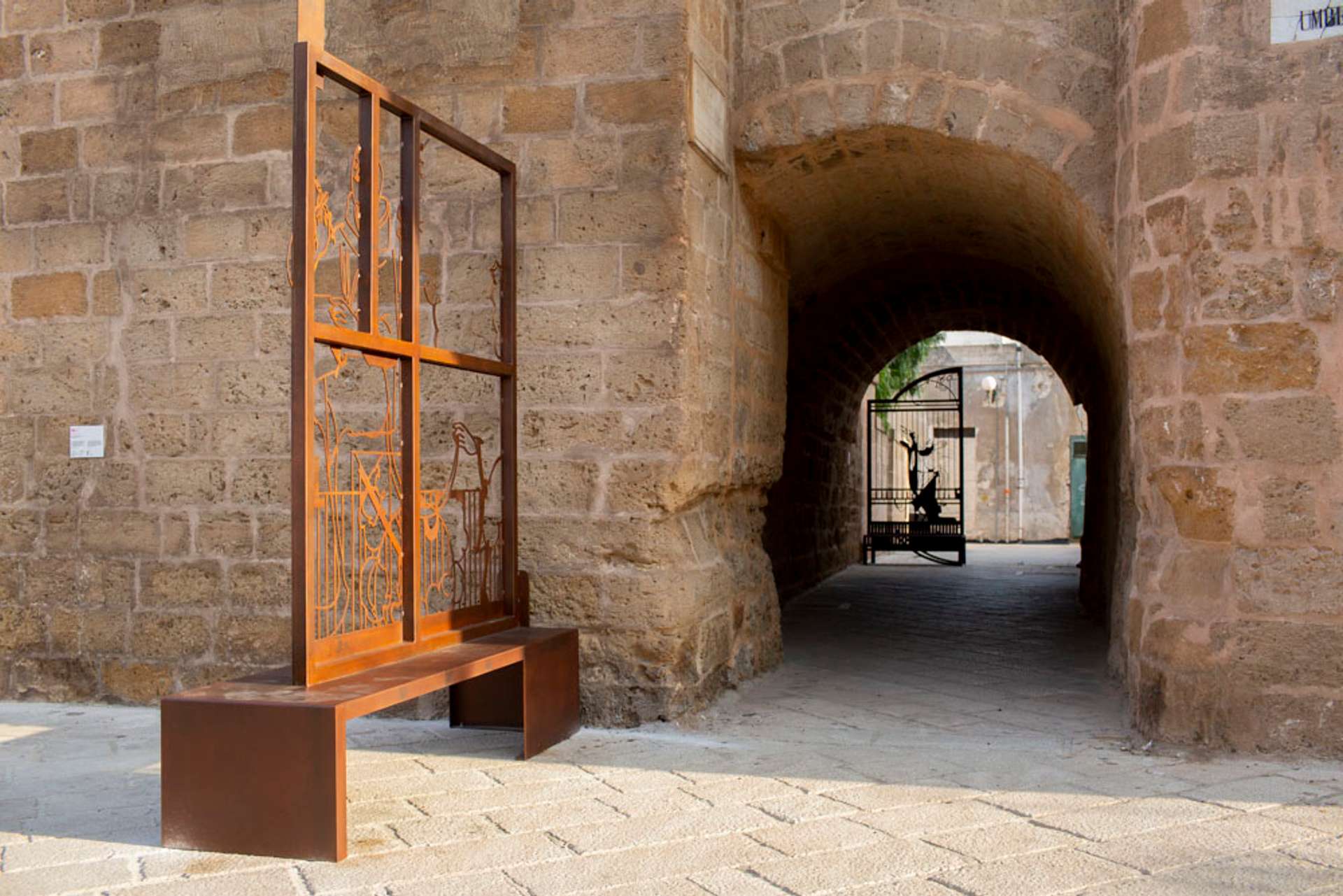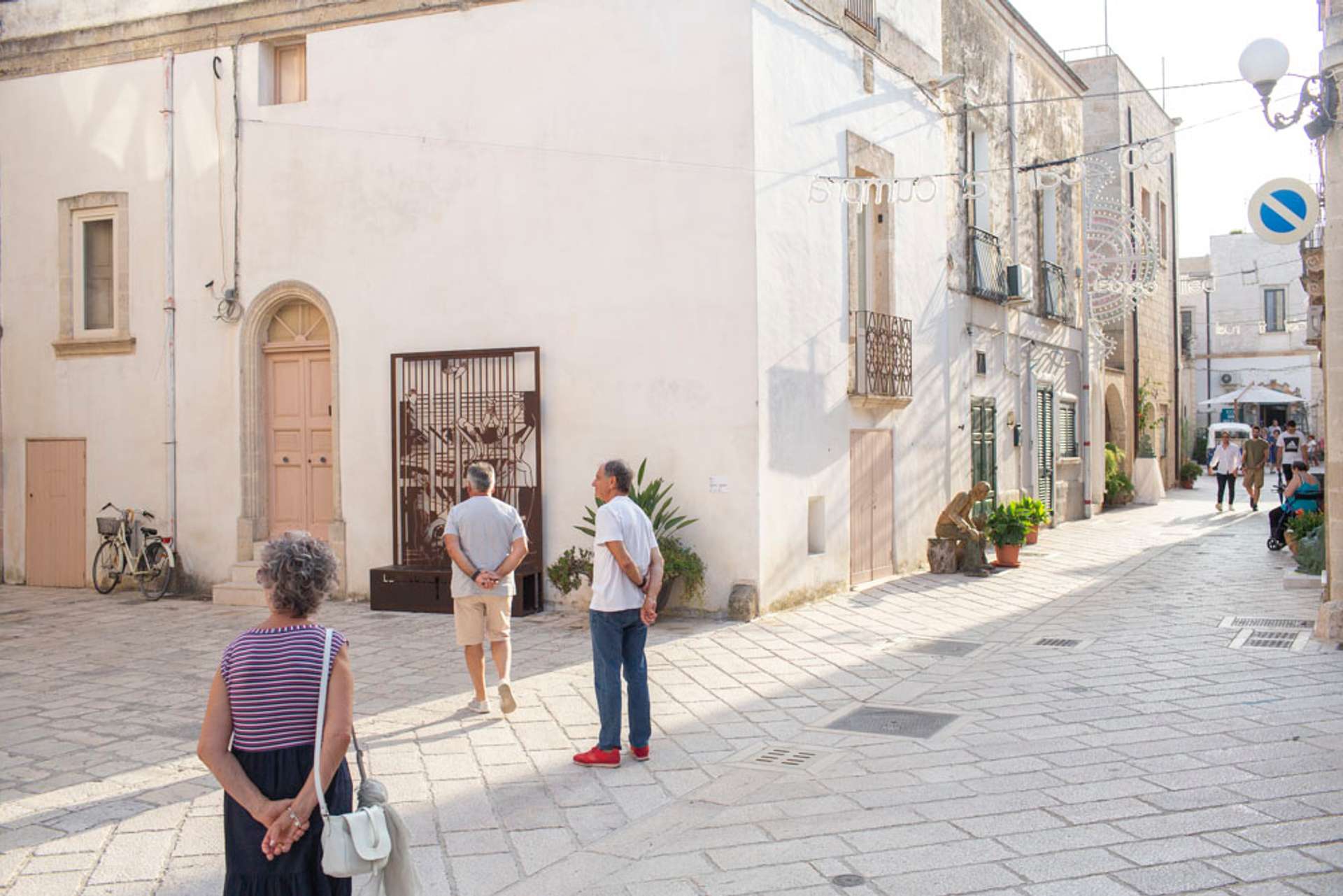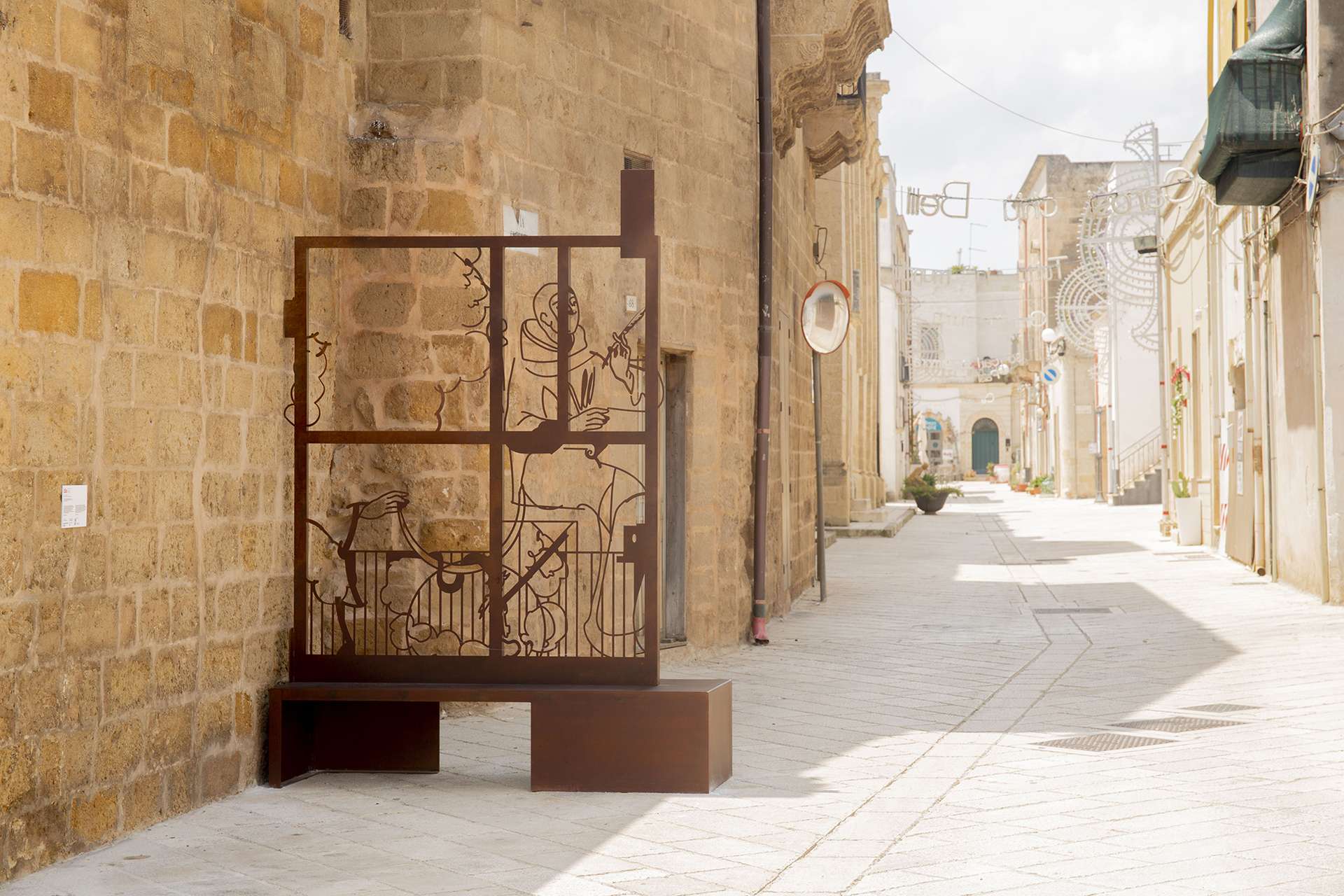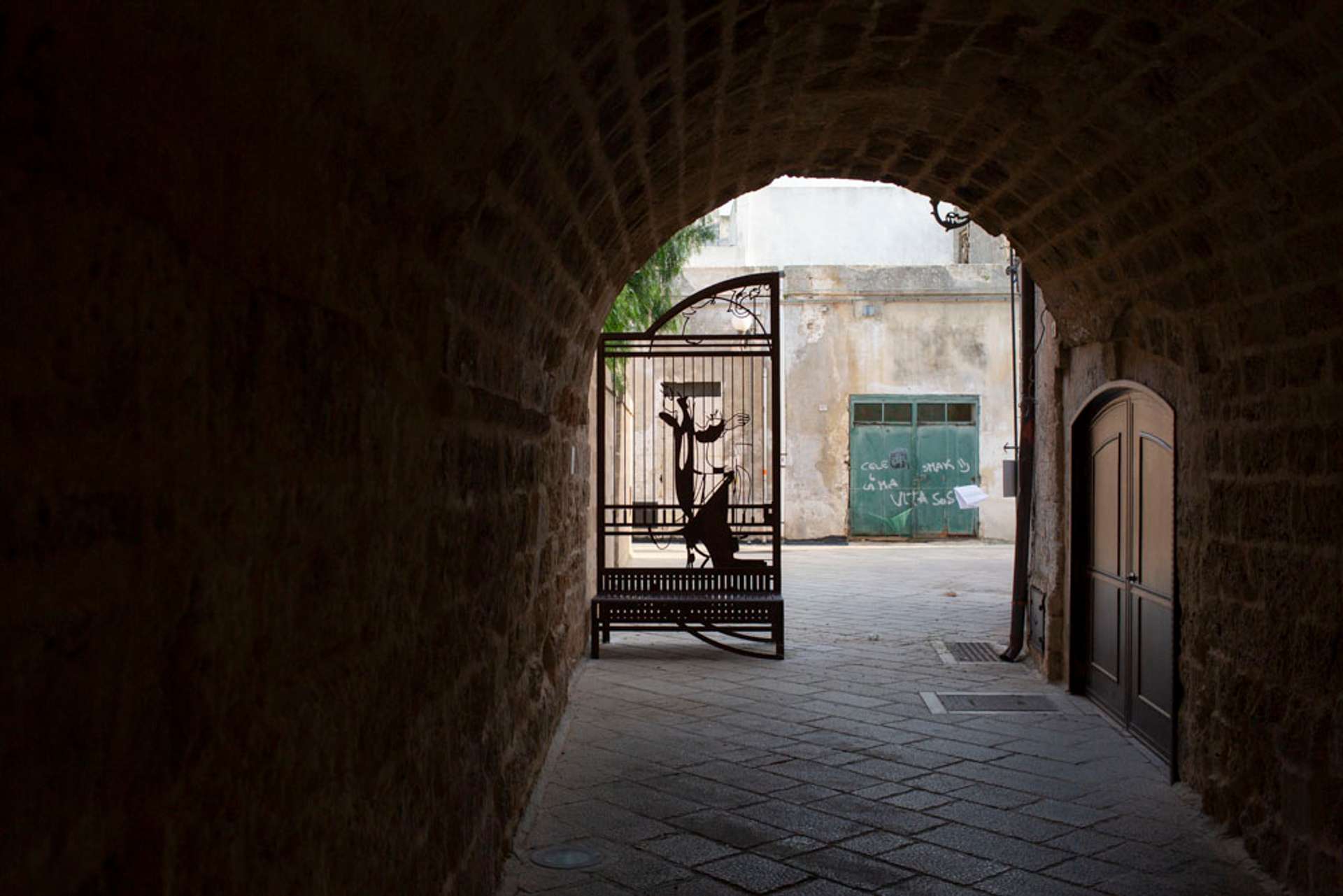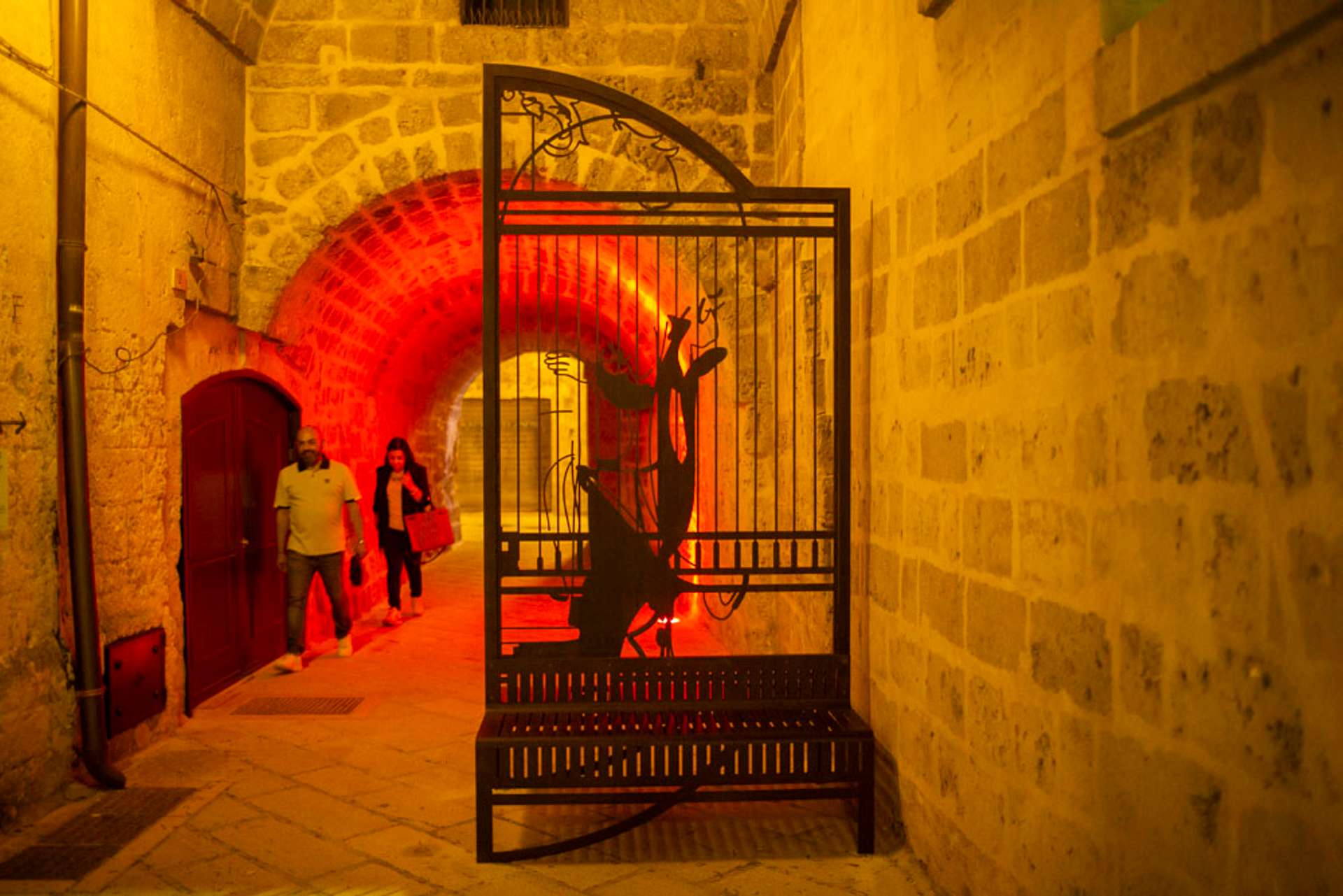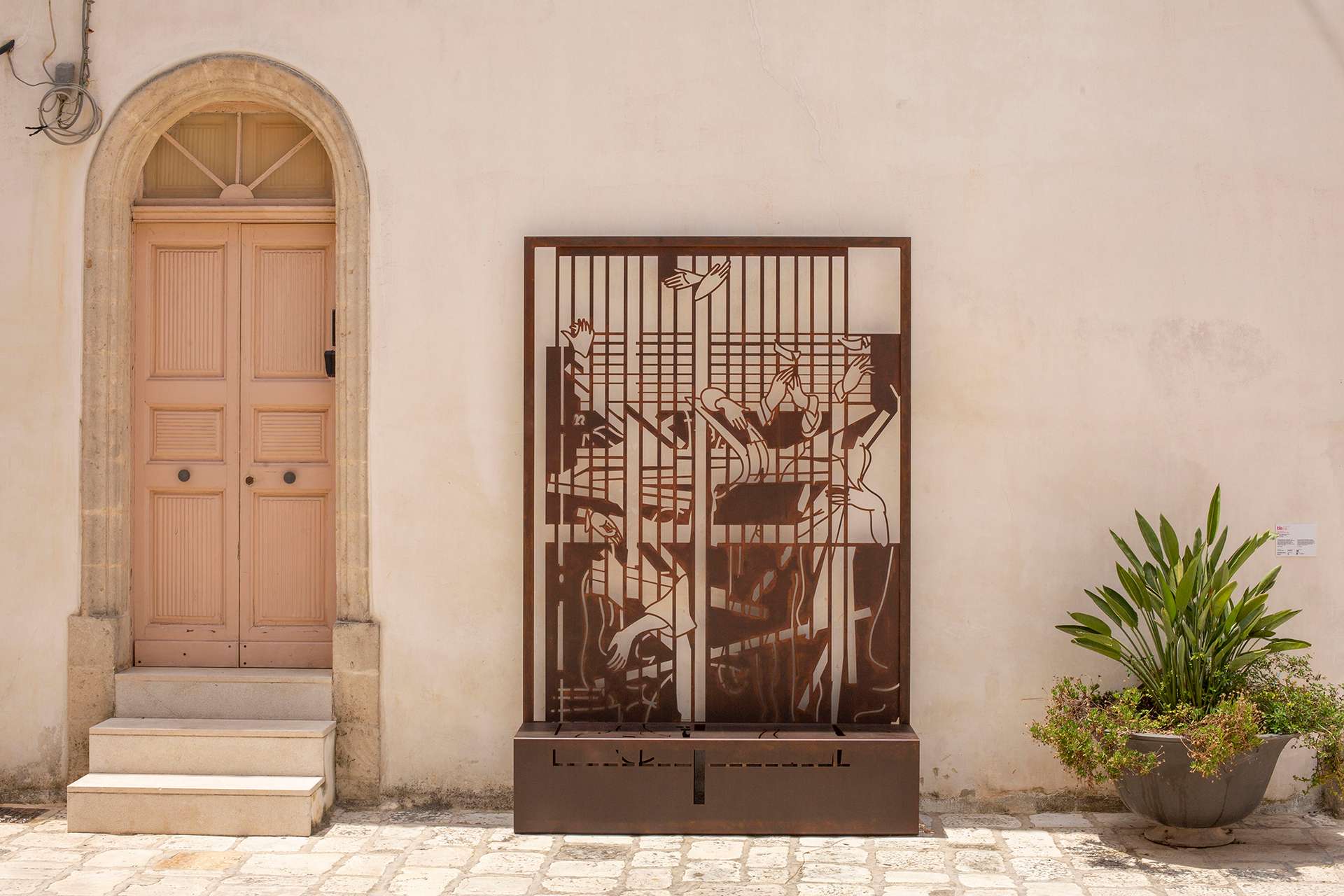In “The Invisible Cities”, Italo Calvino writes about Marco Polo in the presence of Kublai Khan, emperor of the Tartar kingdom, and his extraordinary journey through Asia. Polo’s tale moves between reality and fiction, combining detailed descriptions with reminiscences of scents, sounds and even dreams. The novel tells of intimate but alien cities, defined by spaces, fragments, people and memories.
Evita Vasiljeva visited Maruggio in winter, walking through the half-empty streets of a coastal village at rest and able only to imagine the vitality that summer would hold in store. Moving through the silent streets and listening to the stories and legends cherished by the inhabitants she met, the artist dwelt on the rhythmic presence of discreet but recurring elements: fences and gates. Proposing an alternative to their preclusive function, Vasiljeva has created devices aimed at openness and sharing: three corten portals that adopt the appearance of rusty gratings, combining them with large seats with space for several people. Suggesting the view towards an unexplored world that a gate can offer, the three sculptures flank the inclusive and generative possibility of sitting and imagining together, just as Polo and Khan do in Calvino’s tale.
Barely invisible cities is an invitation to stop, meet and exchange, rooted in the territory, as suggested by the motifs that adorn the sculptures, inspired by the frescoes in the cloister of the Monastery of Santa Maria delle Grazie, which now houses Maruggio’s Town Hall. The gate becomes a metaphor for a reflection on the town, its artistic heritage, its historical present, and the living stories and narratives that bring its urban fabric to life. By unhinging gates and railings, transforming them into usable and habitable platforms, the artist invites us to reflect on the importance of meeting and rediscovering one another, together transforming the boundaries and perspectives of ancient lands that are nonetheless aspiring towards their future.
ㅤ
Permanent works:
01. Evita Vasiljeva, Barely Invisible Cities (I), 2023. Laser cut and engraving on corten steel, 270 x 170 x 45 cm.
Sagrato della Chiesa Matrice della Natività di Santa Maria Vergine, via Umberto I, 64, Maruggio
ㅤ
02. Evita Vasiljeva, Barely Invisible Cities (II), 2023, Laser cut and engraving on corten steel, 300 x 150 x 90 cm.
Secondary entrance to the gardens of Palazzo Caniglia, between via Umberto I and via Verdi, Maruggio
ㅤ
03. Evita Vasiljeva, Barely Invisible Cities (III), 2023. Laser cut and engraving on corten steel, 280 x 200 x 60 cm.
Via Umberto I, 99, Maruggio
TIME STANDS STILL IN MARUGGIO, AS IF CITIZENS SECRETLY KNOW HOW TO SLOW IT DOWN. FRAGMENTS OF HISTORY SPARKLE THROUGH STONE WALLS AND TRACES OF SAINTS WHO WALKED THE STREETS OF THE TOWN. ANOTHER, INVISIBLE, TIMELINE IS PRESENT. THIS BORDER IS MY POINT OF DEPARTURE: A GATE PROTECTING MARUGGIO'S PAST AND FUTURE
Evita Vasiljeva (Riga, Latvia, 1985) lives and works in Paris. Her practice includes sculpture, installation, and sound. Raised in Latvia during the post-Soviet transition, the artist draws from a visual and sonic imagery of suburban architecture and landscapes. She creates objects, devices, and interactive installations by appropriating materials, usually used for construction, such as concrete, armature, metal profiles, lanterns, and various electrical appliances, and by combining them with household objects: beds and blankets, fridges, microwaves, and soap, but also movement sensors which were commonly used in Latvia in the 90s to secure houses. By manipulating and repurposing a large variety of materials, Evita Vasiljeva invents her own aesthetic, as well as provokes relational dynamics between spaces, architecture, memory, and spectators’ bodies. While her works tackle the issues of anxiety and control, through ways of coexistence within the present moment, they always remain open for multiple interpretations.
The artist has participated in the Lyon Biennale (FR, 2022) and Baltic Triennial 14 (LT, 2021). Recent solo and group exhibitions include those at: Cēsis Contemporary Art Center, Cēsis (LT, 2022); Publiek Park, in collaboration with SMAK, Ghent (BE, 2021); Salon de Normandy by the Community, Paris (FR, 2020); Latvian Centre for Contemporary Art, Riga (LT, 2020); Muzeum Sztuki, Lodz (PL, 2020); Kim? Center for Contemporary Art, Riga (LT, 2019); Tallinn City Gallery, Tallinn (EE, 2018); Foundation Ricard, Paris (FR, 2018); P/////AKT, Amsterdam (NL, 2017). Her works are part of the collection of the Latvian National Museum of Art and numerous private collections.
THE ARTIST REFLECTS ON THE PRECLUSIVE FUNCTION OF FENCES AND GATES THROUGH THREE BENCH-SCULPTURES THAT APPROPRIATE THE AESTHETICS OF RUSTY GRATINGS AND REPRESENT AN INVITATION TO STOP, MEET AND EXCHANGE
One of the ‘Borghi più Belli d'Italia’ (Italy's Most Beautiful Villages), Maruggio now has about 5,000 inhabitants and is located on the Ionian-Salentine coast of Apulia with its wonderful sea. Founded in 963 and annexed in about 1100 to the Terra d'Otranto (Land of Otranto) under the Order of the Knights Templar, it then passed to the Knights of Malta who defended it from Turkish pirates and built, in the 15th century, the splendid church Chiesa Madre Santissima Natività di Maria Vergine. The historical centre is a small labyrinth of narrow, winding streets lined by ancient whitewashed dwellings with Renaissance balconies of rare beauty. The landscape of Maruggio is dominated by impressive centuries-old olive trees, traditional masseria farmsteads, votive chapels and the majestic stone trulli (conical houses). Local culinary traditions are closely linked to fishing and agricultural production, such as pipaluri spritti (fried sweet chili peppers) and fai e foji (broad bean and vegetable purée), as well as the two bakery specialities made exclusively in Maruggio: li puddichi, spiced bread baked in all homes at Easter time, and li pezzuri, oven-baked calzones, stuffed pizza envelopes. Maruggio hosts a series of events, including ‘La Strada dei Saperi e dei Sapori’ (The Way of Knowledge and Flavours) and other traditional and religious festivities, such as the feast of the Patron Saints St. John and St. Christopher (13 - 14 July).
